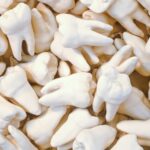Introduction
Premolars are an essential component of your dental anatomy, playing a crucial role in the overall function and aesthetics of your smile. Positioned between your anterior incisors and posterior molars, these unique teeth serve multiple functions that contribute to your oral health and overall well-being.
Typically, adults have a total of eight premolars in their mouths, with two in each quadrant—four in Mandible and four in Maxilla. Premolars are characterized by their flat crowns with multiple pointed cusps, which make them well-suited for their primary functions: cutting, tearing, and grinding food.
In this comprehensive guide, we will delve into the fascinating world of premolars, exploring their anatomy, function, maintenance, and their significance in the context of your oral health. Whether you’re curious about the structure of these teeth, interested in learning how to care for them, or simply want to appreciate their role in your beautiful smile, this blog will provide you with valuable insights and actionable tips. So, let’s embark on a journey to uncover the secrets and importance of premolars in your dental health journey
Anatomy of Premolars
Here we will discuss about the anatomy of each Premolars in detail.
Maxillary 1st premolars

The anatomy of a maxillary first premolar can vary somewhat among individuals, but I can provide you with a general description of the typical features you might find on the lingual (tongue side), buccal (cheek side), mesial (towards the front of the mouth), distal (towards the back of the mouth), and occlusal (top) surfaces of a maxillary first premolar:
Lingual Surface:
- The lingual surface of the maxillary first premolar is the inner surface of the tooth, facing the tongue.
- It usually has a smooth, convex shape.
- There may be a lingual groove or ridge running down the center of the surface, which can vary in size and depth.
Buccal Surface:
- The buccal surface of the maxillary first premolar is the outer surface of the tooth, facing the cheek.
- It typically has a more pronounced shape compared to the lingual surface.
- There are two main buccal cusps (elevated points or areas): a larger buccal cusp towards the front of the tooth (mesial) and a smaller buccal cusp towards the back of the tooth (distal).
- There can be a buccal groove or fissure separating these cusps.
Mesial Surface:
- The mesial surface is the side of the tooth facing towards the front of the mouth.
- It usually has a convex shape.
- Near the gumline, there may be a small depression called the mesial concavity.
Distal Surface:
- The distal surface is the side of the tooth facing towards the back of the mouth.
- It also typically has a convex shape.
- Similar to the mesial surface, there may be a distal concavity near the gumline.
Occlusal Surface:
- The occlusal surface is the top surface of the tooth that comes into contact with the opposing teeth when you bite down.
- It usually has two main cusps: a larger mesiobuccal cusp and a smaller distobuccal cusp.
- Between these cusps, there is usually a groove called the central groove.
- Additionally, there may be smaller grooves and ridges known as supplemental grooves and ridges that help define the tooth’s occlusal anatomy.
Mandibular 1st Premolar

Certainly, let’s break down the anatomy of the mandibular first premolar from various aspects: lingual (towards the tongue), buccal (towards the cheek), mesial (towards the midline), distal (away from the midline), and occlusal (the biting surface).
Lingual Aspect (Toward the Tongue):
- The lingual surface of the mandibular first premolar faces the tongue.
- It is generally smooth and may have a slight concavity.
- There is often a lingual pit near the cervical (near the gum line) area, which can sometimes be a site for dental caries (cavities).
Buccal Aspect (Toward the Cheek):
- The buccal surface of this tooth faces the cheek.
- It is usually more convex and may have a slight ridge running vertically down its center.
- The buccal surface is smoother compared to the occlusal surface.
Mesial Aspect (Towards the Midline):
- The mesial surface of the mandibular first premolar is the side that faces toward the center of the dental arch or midline.
- It often has a contact point with the adjacent tooth, the mandibular second premolar.
- The mesial surface typically appears flat or slightly concave.
Distal Aspect (Away from the Midline):
- The distal surface of the mandibular first premolar faces away from the midline.
- It may also have a contact point with the adjacent tooth, the mandibular second premolar.
- The distal surface is generally similar in appearance to the mesial surface.
Occlusal Aspect (Biting Surface):
- The occlusal surface of the mandibular first premolar is the part that comes into contact with the opposing tooth in the upper dental arch when you bite down.
- It has two main cusps: a larger buccal cusp and a smaller lingual cusp.
- Between these cusps, there is typically a groove called the central groove that runs transversely.
- Additionally, there might be supplemental grooves, fissures, or pits on the occlusal surface that vary among individuals. These can be potential locations for tooth decay (cavities).
Keep in mind that the exact anatomy of a mandibular first premolar can vary among individuals, and in some cases, additional structures or variations may be present. Regular dental check-ups are essential for maintaining the health of your teeth and addressing any specific concerns related to your dental anatomy
Maxillary 2nd Premolar

The anatomy of the maxillary second premolar (also known as the second bicuspid) can vary among individuals, but I can provide you with a general description of its typical characteristics from a lingual, buccal, mesial, distal, and occlusal perspective.
Lingual (Tongue-Side) Surface:
- The lingual surface of the maxillary second premolar is relatively smooth compared to the molars.
- It may have a slight concavity towards the center.
- There is usually a single lingual cusp called the lingual cusp, which is smaller and less prominent than the buccal cusp.
- The lingual surface may have a small ridge called the cingulum that runs around the base of the lingual cusp.
Buccal (Cheek-Side) Surface:
- The buccal surface of the maxillary second premolar is typically flatter and less complex than the molars.
- It features one prominent buccal cusp, which is larger than the lingual cusp.
- The buccal surface may have a groove called the buccal groove, which runs down the center of the crown.
Mesial (Front) Surface:
- The mesial surface of the maxillary second premolar is adjacent to the first premolar.
- It is generally convex in shape, curving outward.
- It may have a small groove or depression near the cervical (gum) margin, known as the mesial pit.
Distal (Back) Surface:
- The distal surface of the maxillary second premolar is adjacent to the first molar.
- It is also convex, curving outward.
- Like the mesial surface, it may have a small groove or depression near the cervical margin, known as the distal pit.
Occlusal (Chewing) Surface:

- The occlusal surface of the maxillary second premolar is typically broader buccolingually (side-to-side) than mesiodistally (front-to-back).
- It features two main cusps: the larger buccal cusp and the smaller lingual cusp.
- There is often a groove called the central groove that divides the occlusal surface into two lobes, with the buccal lobe being larger and more prominent.
- Some maxillary second premolars may have additional smaller grooves or pits on the occlusal surface, which can vary between individuals
Mandibular 2nd Premolar

The anatomy of a mandibular second premolar, like any tooth, can be quite detailed. Here, I’ll provide an overview of the key features and surfaces you’d find on a mandibular second premolar.
Lingual Surface:
- The lingual surface is the surface of the tooth that faces the tongue.
- It’s generally smooth and has a slight concavity.
- There may be a lingual groove, but this is not always present.
- The lingual surface connects to the occlusal surface through the lingual pit, which can sometimes lead to complications like decay.
Buccal (Facial) Surface:
- The buccal surface is the surface of the tooth that faces the cheeks or lips.
- It is usually more convex than the lingual surface.
- In some cases, there may be a buccal groove or a developmental depression, but these features can vary.
Mesial and Distal Surfaces:
- The mesial surface is the side of the tooth that is closer to the front of the mouth.
- The distal surface is the side of the tooth that is closer to the back of the mouth.
- These surfaces are generally smooth and connect the buccal and lingual surfaces.
- The contact areas on these surfaces are important for proper alignment and function with adjacent teeth.
Occlusal Surface:
- The occlusal surface is the chewing surface of the tooth.
- Mandibular second premolars usually have two cusps – a larger buccal (or labial) cusp and a smaller lingual (or palatal) cusp.
- There’s often a central groove that separates these cusps, and it may have supplementary grooves or pits.
- The central groove can sometimes extend into the buccal and lingual grooves
Functions of premolars
Chewing and Grinding:
Premolars are situated in the posterior (back) of your mouth, making them well-suited for grinding and crushing food. Their flat crowns and multiple cusps (the pointed parts) enable them to effectively break down food particles into smaller pieces, which is an essential step in the digestive process.
Food Processing:
These teeth help process different types of food, especially tougher or fibrous items like meats and vegetables. They work in conjunction with your molars to masticate (chew) food thoroughly, making it easier to swallow and digest.
Supporting Digestion:
Properly chewing your food with premolars and molars is crucial for the digestive process. Adequate chewing helps break down food into smaller particles, which allows digestive enzymes to work more effectively in the stomach and small intestine.
Maintaining Proper Bite and Alignment:
Premolars help maintain the alignment and stability of your bite. They serve as intermediaries between your incisors (front teeth) and molars (rear teeth) and contribute to the even distribution of biting forces when you chew.
Aesthetic Balance:
In addition to their functional roles, premolars also contribute to the aesthetics of your smile. They are visible when you speak and smile, so their proper shape, size, and alignment are important for a pleasing appearance.
Supporting Adjacent Teeth
Premolars are strategically positioned in the mouth to provide support to neighboring teeth. They help distribute the pressure generated during chewing and prevent excessive wear and tear on adjacent teeth.
Facilitating Speech:
Your premolars, especially the upper ones, are involved in the formation of certain speech sounds. They aid in articulating words and sounds that require contact between the tongue and the upper premolar teeth.
To know about other tooth anatomy do follow The Tooth Times
For blogs about lifestyle do follow Trending Curiosity
Get some knowledge about Civil engineering do follow Civil Engineer Academy








